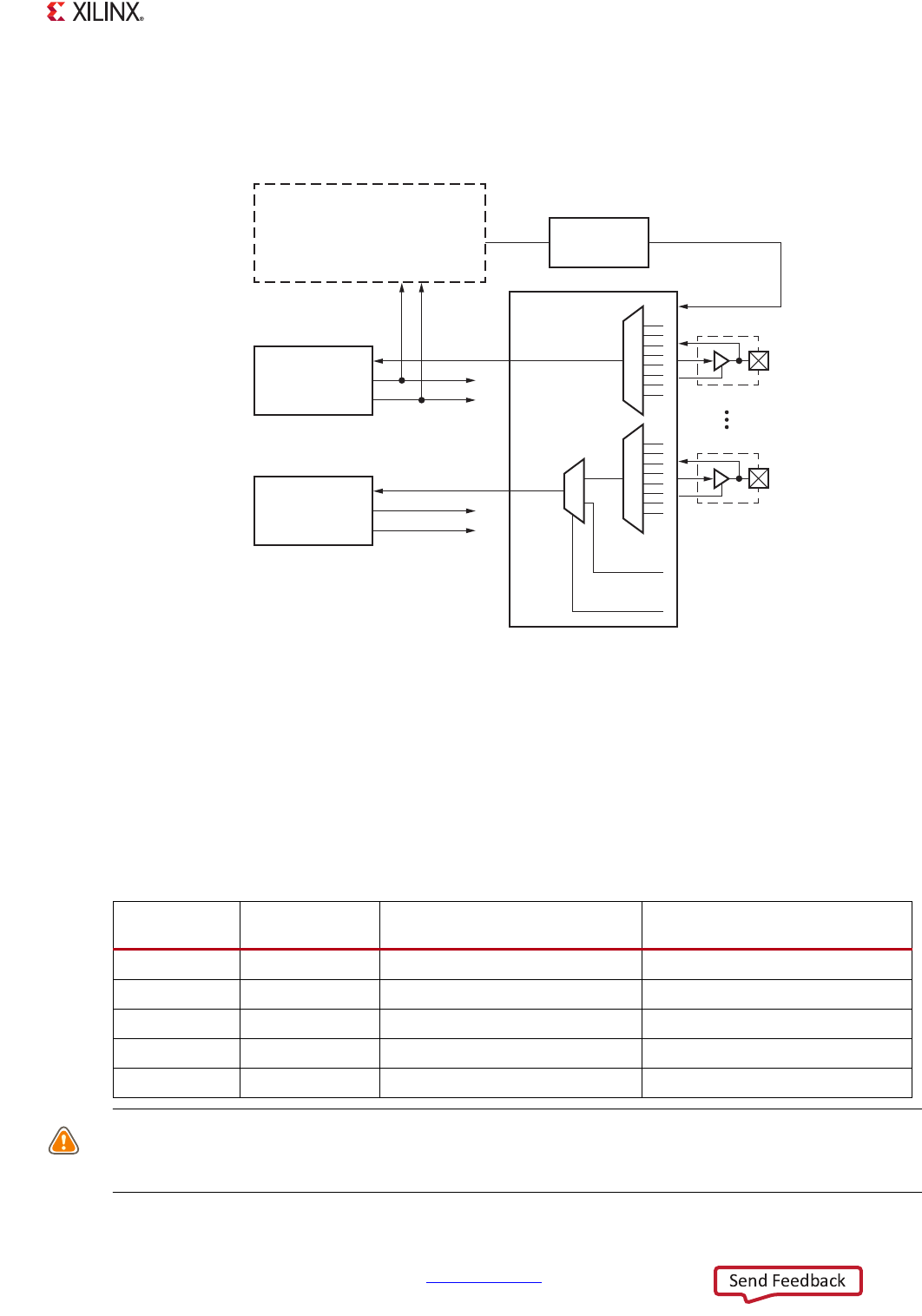User manual
Table Of Contents
- Zynq-7000 All Programmable SoC
- Table of Contents
- Ch. 1: Introduction
- Ch. 2: Signals, Interfaces, and Pins
- Ch. 3: Application Processing Unit
- Ch. 4: System Addresses
- Ch. 5: Interconnect
- Ch. 6: Boot and Configuration
- Ch. 7: Interrupts
- Ch. 8: Timers
- Ch. 9: DMA Controller
- Introduction
- Functional Description
- DMA Transfers on the AXI Interconnect
- AXI Transaction Considerations
- DMA Manager
- Multi-channel Data FIFO (MFIFO)
- Memory-to-Memory Transfers
- PL Peripheral AXI Transactions
- PL Peripheral Request Interface
- PL Peripheral - Length Managed by PL Peripheral
- PL Peripheral - Length Managed by DMAC
- Events and Interrupts
- Aborts
- Security
- IP Configuration Options
- Programming Guide for DMA Controller
- Programming Guide for DMA Engine
- Programming Restrictions
- System Functions
- I/O Interface
- Ch. 10: DDR Memory Controller
- Introduction
- AXI Memory Port Interface (DDRI)
- DDR Core and Transaction Scheduler (DDRC)
- DDRC Arbitration
- Controller PHY (DDRP)
- Initialization and Calibration
- DDR Clock Initialization
- DDR IOB Impedance Calibration
- DDR IOB Configuration
- DDR Controller Register Programming
- DRAM Reset and Initialization
- DRAM Input Impedance (ODT) Calibration
- DRAM Output Impedance (RON) Calibration
- DRAM Training
- Write Data Eye Adjustment
- Alternatives to Automatic DRAM Training
- DRAM Write Latency Restriction
- Register Overview
- Error Correction Code (ECC)
- Programming Model
- Ch. 11: Static Memory Controller
- Ch. 12: Quad-SPI Flash Controller
- Ch. 13: SD/SDIO Controller
- Ch. 14: General Purpose I/O (GPIO)
- Ch. 15: USB Host, Device, and OTG Controller
- Introduction
- Functional Description
- Programming Overview and Reference
- Device Mode Control
- Device Endpoint Data Structures
- Device Endpoint Packet Operational Model
- Device Endpoint Descriptor Reference
- Programming Guide for Device Controller
- Programming Guide for Device Endpoint Data Structures
- Host Mode Data Structures
- EHCI Implementation
- Host Data Structures Reference
- Programming Guide for Host Controller
- OTG Description and Reference
- System Functions
- I/O Interfaces
- Ch. 16: Gigabit Ethernet Controller
- Ch. 17: SPI Controller
- Ch. 18: CAN Controller
- Ch. 19: UART Controller
- Ch. 20: I2C Controller
- Ch. 21: Programmable Logic Description
- Ch. 22: Programmable Logic Design Guide
- Ch. 23: Programmable Logic Test and Debug
- Ch. 24: Power Management
- Ch. 25: Clocks
- Ch. 26: Reset System
- Ch. 27: JTAG and DAP Subsystem
- Ch. 28: System Test and Debug
- Ch. 29: On-Chip Memory (OCM)
- Ch. 30: XADC Interface
- Ch. 31: PCI Express
- Ch. 32: Device Secure Boot
- Appx. A: Additional Resources
- Appx. B: Register Details
- Overview
- Acronyms
- Module Summary
- AXI_HP Interface (AFI) (axi_hp)
- CAN Controller (can)
- DDR Memory Controller (ddrc)
- CoreSight Cross Trigger Interface (cti)
- Performance Monitor Unit (cortexa9_pmu)
- CoreSight Program Trace Macrocell (ptm)
- Debug Access Port (dap)
- CoreSight Embedded Trace Buffer (etb)
- PL Fabric Trace Monitor (ftm)
- CoreSight Trace Funnel (funnel)
- CoreSight Intstrumentation Trace Macrocell (itm)
- CoreSight Trace Packet Output (tpiu)
- Device Configuration Interface (devcfg)
- DMA Controller (dmac)
- Gigabit Ethernet Controller (GEM)
- General Purpose I/O (gpio)
- Interconnect QoS (qos301)
- NIC301 Address Region Control (nic301_addr_region_ctrl_registers)
- I2C Controller (IIC)
- L2 Cache (L2Cpl310)
- Application Processing Unit (mpcore)
- On-Chip Memory (ocm)
- Quad-SPI Flash Controller (qspi)
- SD Controller (sdio)
- System Level Control Registers (slcr)
- Static Memory Controller (pl353)
- SPI Controller (SPI)
- System Watchdog Timer (swdt)
- Triple Timer Counter (ttc)
- UART Controller (UART)
- USB Controller (usb)

Zynq-7000 AP SoC Technical Reference Manual www.xilinx.com 54
UG585 (v1.11) September 27, 2016
Chapter 2: Signals, Interfaces, and Pins
The default input signal logic levels are designed to be benign to the I/O peripheral. As a precaution,
the related peripheral core should also be disabled when not in use. The logic levels are shown in the
signal tables in each chapter for each I/O peripheral.
2.5.7 MIO Pin Electrical Parameters
The MIO_PIN registers include bit fields to control the electrical pin characteristics of each I/O Buffer
(GPIOB). This includes I/O buffer signaling voltage, slew rate, 3-state control, pull-up resistor, and
HSTL enable. These are summarized in Table 2-5. Refer to the applicable Zynq-7000 AP SoC data
sheet for electrical specifications.
CAUTION! The allowable Vin High level voltage depends on the settings of the
slcr.MIO_PIN_xx[IO_Type] and [DisableRcvr] bits. The restrictions are defined in the Zynq-7000 AP SoC
data sheets. Damage to the input buffer can occur when the limits are exceeded.
X-Ref Target - Figure 2-5
Figure 2-5: Non-selected Controller Inputs
UG585_c2_05_042312
Hardcoded
Tie-Offs
0
EMIO Output
EMIO Input
Voltage translation
and drives a default
value to the MIO mux.
EMIO Inputs
1
No Interface
Selected
Subsystems
With MIO And
EMIO Routing
MIO Mux
Input Signal
Tie-Offs
Programmable
Logic
MIO
Pins
Subsystems
With MIO-only
Routing
Table 2-5: MIO I/O Buffer Programmable Parameters
I/O Buffer
Parameter
MIO_PIN Register
Bit Field
Selections Comments
Signaling I/O_Type LVCMOS (18, 25, 33), HSTL Selects the drive and receiver type
HSTL Receiver DisableRcvr Enable, Disable Enable when IO_Type = HSTL
Slew Rate Speed Fast, Slow Selects edge rate for all I/O types
3-State Control 3-State Control Enable, Disable Enables 3-state for all I/O types
Pull-up Pull-up Enable, Disable Enables pull-up for all I/O types










